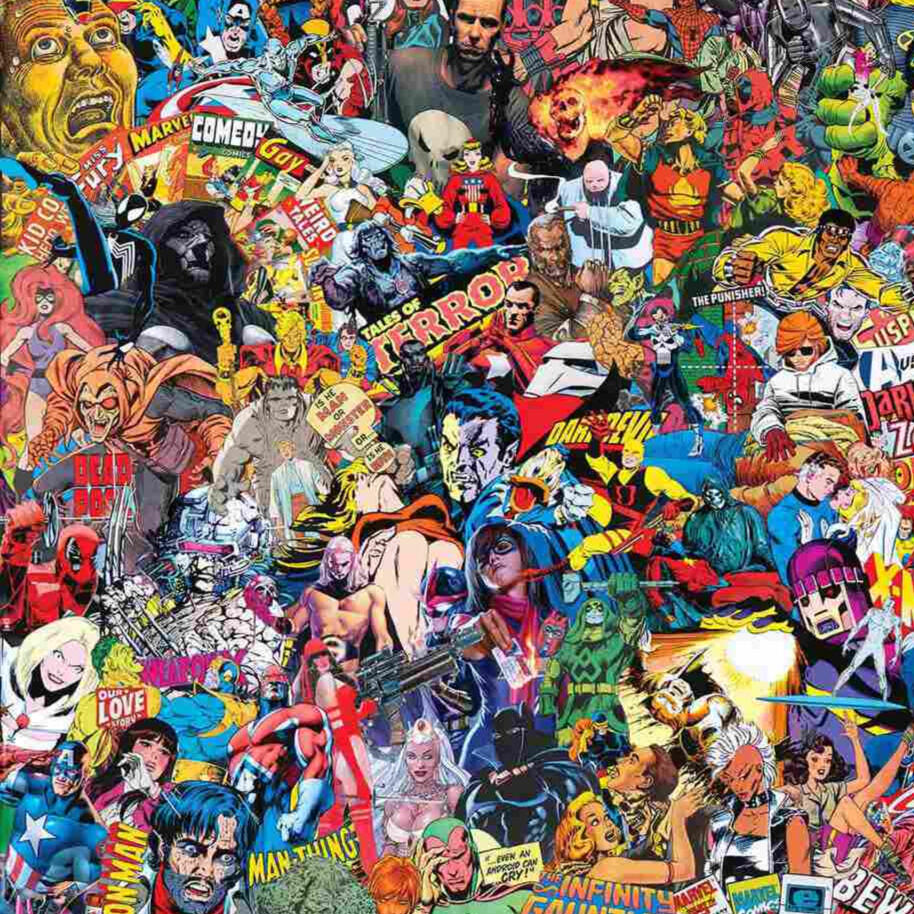
superhero costume design
an overview
Costume design is a huge part of visual storytelling. It’s so much more than an aesthetic decision - a character’s costume can clue the viewers in to their personality, heritage, and storyline. A costume can make a character stand out, or let them blend in. The 20th century brought film and television into the home, bringing with it stories, characters and costumes from all over the world.In the world of superheroes, costumes play a big part, feeding directly into the storylines. Heroes are public figures, in their own worlds and in ours, and costumes are a big part of their image. Good costumes are simple, memorable, and are recognisable instantly.In the 21st century, the reputable designers of hero costume are mostly working on the big screen. Michael Wilkinson, renowned for his work with director Zack Snyder in the DCEU. Andy Park, the director of visual development and a concept artist at Marvel Studios. Mayes C. Rubeo and Alexandra Byrne, the geniuses behind the fun-filled costumes of Thor: Ragnarok and Guardians of the Galaxy respectively. The award-winning Black Panther was costumed by Ruth E. Carter, who pulled influences from every part of African tribal history. Despite the dropping popularity of superhero comics, and the fact that a lot of their original designers just aren’t around anymore, there is still a lot to learn from modern superhero outfitters.
project purpose
The aim of this project is to analyse and explain the costumes of heroes both on paper and on screen, finding common themes and trends before translating those into my own, original design.
index
history
theory
process
anime and manga
"Moon Prism Power, Make Up!"
Superheroes in manga and anime are an interesting comparison to western superheroes. Japanese hero Ōgon Bat is regarded as the world’s first comic book hero, making his debut in 1931, at least 3 years before any western heroes. Even so, superheroes didn’t really take off in Japan until after the war, in the 1950s, where characters such as Astro Boy first made an appearance. The 70s brought with it franchises such as Science Ninja Team Gatchaman, a hugely popular anime with strong western influences. Throughout the 2000s, Marvel worked with Japanese studios to create the Marvel anime and mangaverse. Today, a shōnen superhero anime called My Hero Academia is one of the most successful franchises in all of Japan, catching up to internationally recognised names such as Pokémon and Star Wars.
superhero comics
where did we start?
Superman is widely regarded as the first western comic hero, first published in June 1938. But upon further inspection, Mandrake the Magician, a superhero with mind-control powers, may take first place. He first appeared in a newspaper in June of 1934, four years prior to Superman. In 1936, The Phantom was also introduced to the world by the same author, a well known character who is still around today.In the 1930s, DC was by far the most prominent in the comic book scene. But in the 1940s, many more prolific publishers appeared, including Fawcett Comics, Standard Comics, Quality Comics, and Timely (which would later become Marvel). After the war, and the publication of a book called Seduction of the Innocent, the 1950s saw a steep decline in the popularity of comics, and by 1954, DC’s Batman, Superman, and Wonderwoman were the only superheroes with their own titles. In the 1960’s, though, Timely made a return, this time as Marvel. Today, DC and Marvel are still the most popular creators of superhero related entertainment.
big screen heroes
how did we get here?
Superheroes first made their way to the big screen in the form of Saturday film serials aimed at young children, following their rise to prominence in comics. This began with Mandrake the Magician (1939), but continued throughout the forties with titles such as The Shadow, Adventures of Captain Marvel, Batman, The Phantom, Captain America, and Superman. The rise of big-budget sci-fi and fantasy films in the 80s gave new life to the superhero genre. Many of the films at the time, though, were criticised for their jokey tongue-in-cheek takes on the stories, and soon enough, some grittier adaptations popped up, with a new wave of more violent and intense films bridging the gap between traditional action movies and the younger audiences of the time. This can be seen most notably in Tim Burton’s Batman and Batman Returns, Alex Proyas’ The Crow. Costumes began to develop, branching out from the cheesy spandex of the 60s, as the steadily growing budgets afforded more wriggle room. This continued into the 21st century with what is often referred to as the ‘superhero renaissance’. The Matrix (1999) is often credited for this reinvention of superhero film, with bullet-time and other techniques providing a way to demonstrate superhuman abilities that were previously impossible to replicate in film. Since then, superhero blockbusters have only grown in popularity, budget, and grandeur. This, of course, has brought with it some incredible costuming.
cosplay
why is it important?
The official birth of cosplay is generally considered to be the 1939 1st World Science Fiction Convention, (Worldcon), when scifi fans Forrest J Ackerman and Myrtle R. Douglas showed up in costume. The trend caught on, though, with both an official and unofficial masquerade held at the next year’s 1940 Worldcon. These masquerade and costume balls continued at the following cons, and became a long-running tradition. Since then, the popularity of cosplay has boomed alongside pop culture, gaining traction not only at conventions, but in huge online communities as well. Cosplay makes up a huge part of every fanbase, but it’s particularly prominent in superhero communities, with fans recreating often incredibly complex costumes. Many designers, when translating costumes from comics to the big screen, will take a lot of inspiration from cosplayers. They’re incredibly creative, and have to figure out how to make stuff that not only looks great, but is cheap and accessible. In a study of superhero costuming, it’s very important to take cosplay into account.
the basics
what even are costumes, really?
I’ve talked a lot about the history and the context of superheroes and their costumes, but what are they, really?
There are 6 principles to consider when discussing the theory behind costuming. Understanding the basics is important, as it gives you a scaffold for your own analysis.Size
This refers to both proportion and scale. Size can be a good representation of how a character interacts with the world. For example, if the costume is oversized, swamping the character, it can symbolise fragility, youthfulness, and inexperience, whereas tight fitting and well tailored costume can indicate strength and status - this particular example could be compared to the the sentiment that a well tailored suit makes a person look much more put together than something off-the-rack.Shape
Shape is an important technique, as it helps with emphasis, and the visual rhythm of a character. If you’re at all interested in character design, you may have heard of the language of shapes. Often, characters will be built primarily with one shape, and a costume can emphasise that. Take our D&D heroes Taako, Merle, and Magnus from the Adventure Zone. Merle, easygoing and good-humoured, is a circular character. Magnus, hot-headed and brave, is rectangular; and Taako, sarcastic and prickly, is primarily triangular. And no matter whether it’s props, accessories, shoulder pads, belts - every part of their costuming reflects these shapes, and consequently, their personalities.
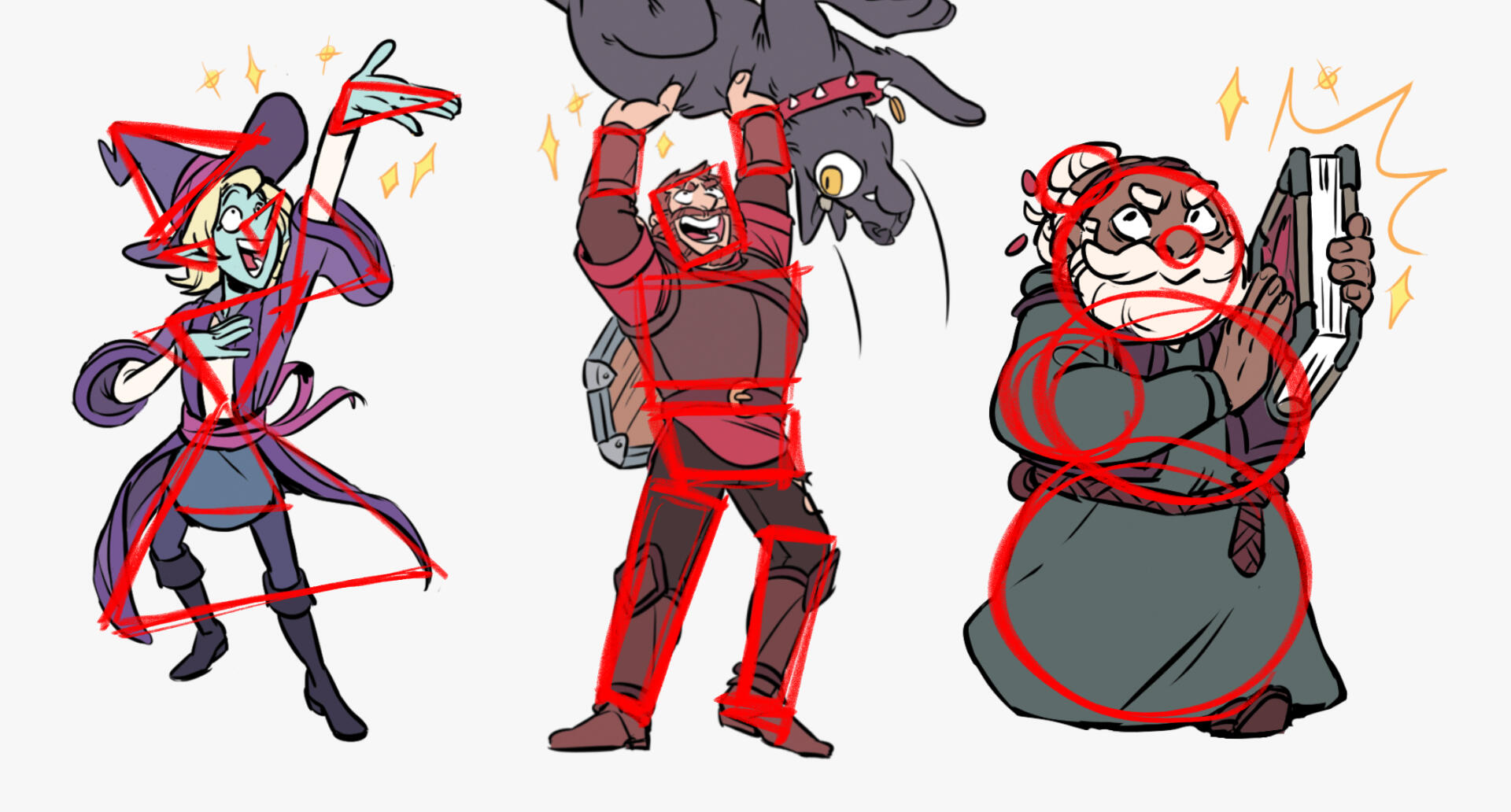
Colour
Tone and scheme can be a huge indicator of a character’s story. A good basic representation of colour and personality is Batman vs Superman. Superman is a public hero, bright and valiant and well-loved. It’s no surprise that he is clad in bold reds and blues, with yellow accents here and there. Batman, on the other hand, is everyone’s favourite morally grey vigilante. His costuming reflects this, thanks to Tim Burton’s hand in the franchise, who remodelled the grey and purple Batman of the 60s into the more intense, grittier version of himself that we know today - and a big part of that was the transition to a much darker palette.Texture
Often, texture can be a great representation of the era and worldly situation that a hero is a part of. Shiny, spandex-clad characters like Spiderman tend to find themselves in big metropolitan cities, whereas foreign leather look fabrics and dark wash cottons can often be found on the backs of our interstellar heroes, as seen in Guardians of the Galaxy. Texture is a great way to set the scene with nothing but a glimpse at the character.Practicality
Use and duality are especially important to superhero characters, but practicality also refers to the real world. For example, Superman’s blue costume was given its red accents in order to make him distinguishable in tiny fight-scene panels in his comics, as the printing at the time made it hard to make out any notable shapes. In terms of duality, My Hero Academia is a great example. In this particular mangaverse, the primary function of a hero’s costume is to both enhance performance and negate any adverse effects of their abilities. When a costume’s practicality and duality are both maxed out, it aids the viewer in their understanding of the characters strengths and weaknesses.Symbolism
This category is interesting, as it can get pretty complex, and can require extensive knowledge of the context or world fiction in order to pick up on it. Unlike the other categories, symbolism is often used to enhance the intricacies of the story and to further connect the character to the world around it - although of course this is not always the case. An example of symbolism that relies on real world context is Wonder Woman’s Lasso of Truth. It was inspired by William Moulton Marston’s work in psychology and lie detection, and was a representation of “feminine allure,” and the idea that it was more about submission than the truth itself. Rather than just a weapon, it is an extension of the character herself.Now, with a general understanding of the theory and principles of superhero costume design, the analysis of such costumes becomes much simpler.
case studies
an in-depth look at some of our most beloved characters.
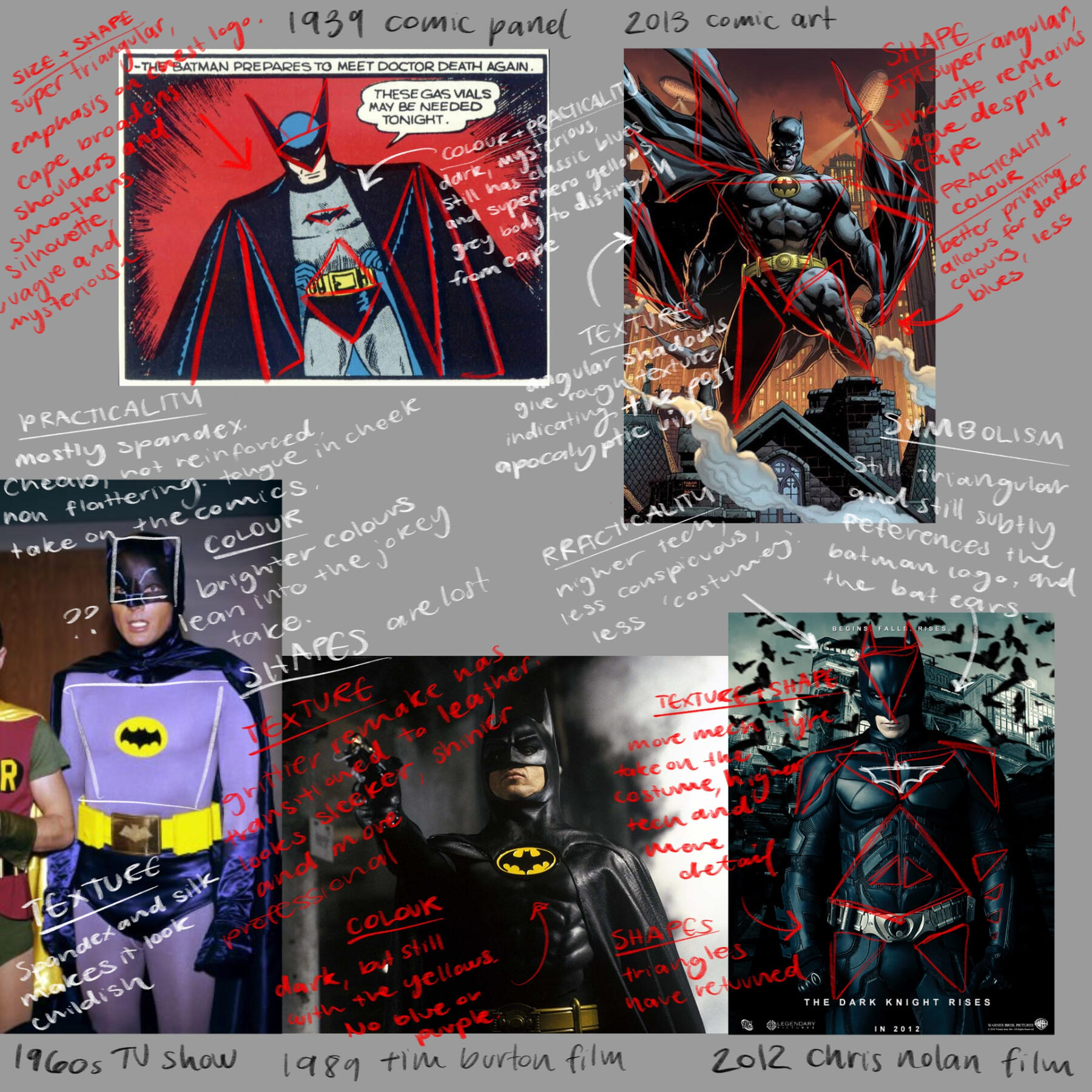
Batman, 1939 to present
In the majority of his iterations, Batman is a dark, angular, and mysterious character. His mask and bat-winged cape gives him a broad-shouldered, vague silhouette that is all sharp angles and harsh edges. Batman’s traditional 1939 design is a popular one, with a blue-black cape and a grey bodysuit, accented with yellow. Today’s comic version of Batman is a much more defined, much darker, and textured character, with better printing allowing for more details to come through in shading, and not needed to leave as much up to the imagination. Batman’s first major film adaptation in the ‘60s was a much more easygoing take on the character, with actor Adam West clad in purple spandex. This series established Batman as a bit of a joke - but this changed with Tim Burtons ‘89 adaptation, where they migrated from bright purples and yellows to black leather, going with a much more sculpted look. Christopher Nolan’s critically acclaimed Dark Knight trilogy takes yet another step in this direction. These films feature an even darker batman, lacking colour entirely. Batman’s suit in the Dark Knight films is a more technologically advanced, tactical suit, veering away from the traditional ‘costume’ look, suiting Batman’s rebellious persona.
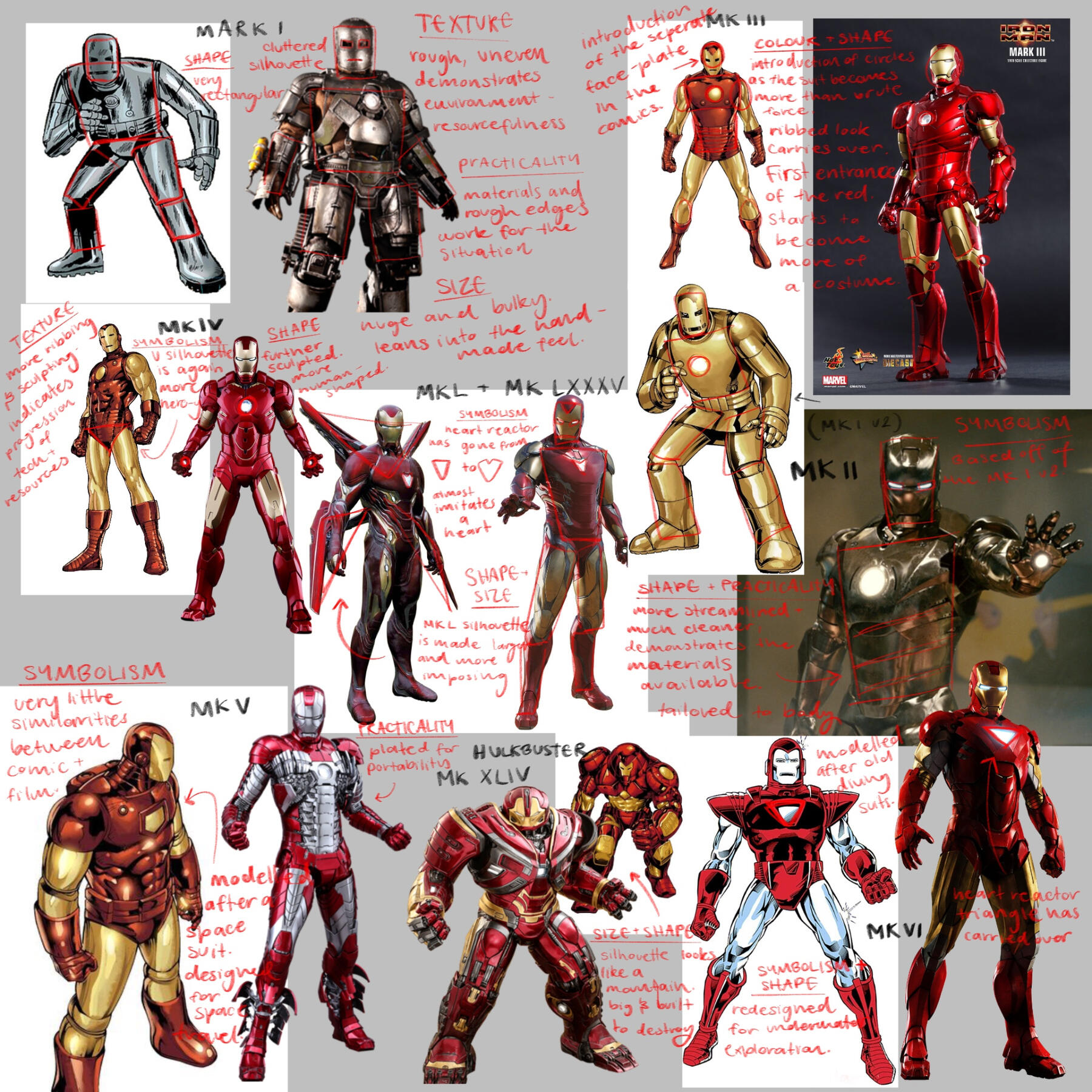
Iron Man, 1963 to present
The development of his suit is a huge part of Iron Man’s storyline, going all the way from mark I to mark LXXXI. Overall, Iron Man is a pretty rectangular character, with circular and triangular accents that vary from mark to mark. The mark I is a grey suit made of scrap metal, built both to keep Tony Stark alive, and help him escape from forgein captivity. This is upgraded to the mark II once he makes it home. The mark III and IV are more fitted, and see the introduction of separate faceplates, repulsors, and red panels on the suit. The mark V differs a lot between the comic and film iterations, with the comic suit modelled after a spacesuit, while the mark V in the film is a lightweight, grey and red suit. The mark VI suits also have few comic-movie similarities apart from their underwater capabilities, but we do see the introduction of the triangular reactor. As the progression continues from mark L to LXXI, there are few major differences, apart from slight changes in colour, silhouette, and aptitude. All in all, Iron Man’s suits make use of texture, shape, and size to demonstrate the change in Iron Man’s story and character.
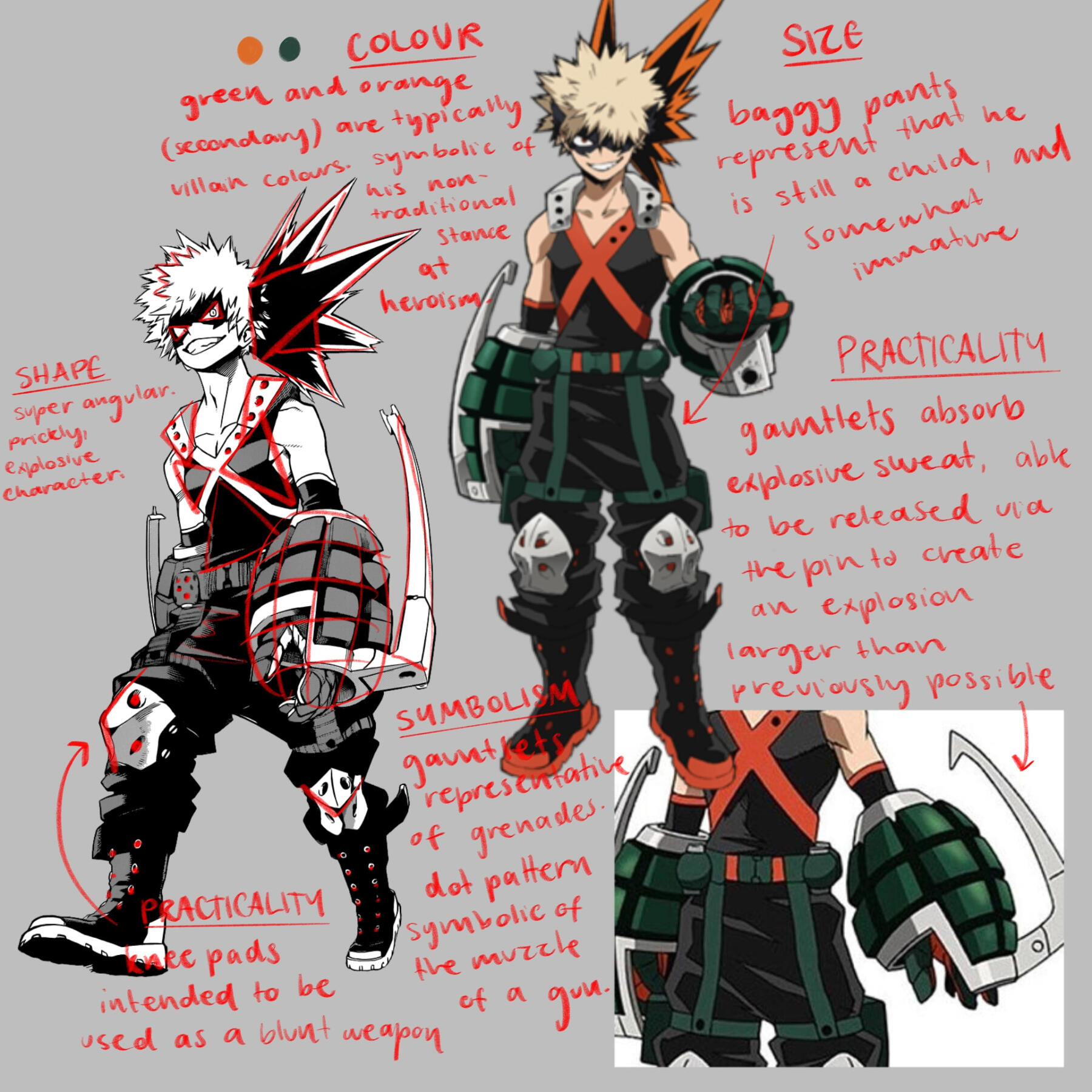
Bakugou Katsuki, 2014 to present
Bakugou Katsuki, one of the main characters in Horikoshi Kouhei’s My Hero Academia, is a great example of the crossover of practicality and symbolism. He is (literally) a super volatile character, with explosive sweat to accompany his unstable temperament. Clad in black, orange and green, Bakugou boasts colours that are traditionally reserved for villains, demonstrating his unusual approach to heroism. Huge gauntlets shaped like hand grenades provide not only a visual aid for the character’s abilities - the gauntlets soak up the sweat, storing it to provide the ability for much bigger explosions that are not possible for Bakugou to produce without aid. Excess sweat is stored in actual hand grenades that sit on a belt around his waist. Bakugou’s costume integrates symbolism with fashion. Circular patterns that emulate the muzzle of a gun are repeated in the neck brace, knee pads, and the hand grenades, but it’s also found in the shoes - one of the costume’s more street-style aspects. Overall, Bakugou’s costume is an impressive intersection of the many aspects of design, coming together for a perfect depiction of the character himself.
conclusions
so, what have we learned?
So now we know a little bit more about costumes, but how is that gonna help when designing an original?
Making use of the prior case studies, knowledge of the principles of costume design, as well as some extra research, I’ve constructed a plan of action for superhero costume design.Influences
The inspiration for costumes can be drawn from many different places, but after researching and reading many different interviews, I’ve collected some common themes. Cosplay, comics, greek gods, and current fashion are all popular ways to garter some motivation for an original design. This is also a common place for character symbolism to originate.*Silhouette *
Silhouette is one of the most important parts of costume design. A character should be recognisable by their silhouette, and it should give a hint to the characters personality and general vibe. Deciding on a silhouette also means deciding on which shape to base your character off of, as well as size.Colour Theme
Colour language is a super important part of character design. There are general things, like warm colours for a flame-based hero, or cool colours for a water-based one, but there are also more intricate things to consider. For example, heroes are traditionally primary colours - red, blue, and yellow - and villains are secondary colours - purple, orange, and green. However, these rules are prone to be broken for symbolism’s sake. Other colour symbolism is also interesting to consider, such as purple for status and royalty, and red for bravery and passion.Practicality
Duality and use is a fun thing to think about when creating a costume. How does your character fight? What are their strengths, or their weaknesses? Are they a rogue type, focussed on sneaking and trickery, or a true fighter, relying on brute force alone? A costume should not only represent a character’s personality, story, and capabilities, but should function completely in the world of it’s fiction.Materials
In terms of illustration, this category refers mostly to texture. But when you’re considering translating a costume over to the real world, it gets a little more complex. In an era where many costume designers are 3d-printing their own fabrics, cosplayers are a huge inspiration. EVA foam, spandex, and faux leather are commonly used in the cosplay community.Once these steps have been completed, you should end up with a pretty well fleshed-out superhero costume.